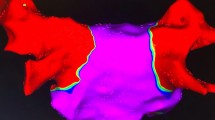Abstract
Multiple wavelet hypothesis and fibrillatory conduction are believed to be atrial fibrillation’s pathogenesis. Radio frequency ablation (RFA) technique, a therapy for atrial fibrillation (AF), applies radio frequency (RF) energy to targeted tissue to make it transmural. Research on AF ablation has already been conducted in China. Currently, there are single-electrode and dual-electrode ablation electrodes. It is discovered that the latter can reduce the treatment time and maintain the ablation shape of the tissue. Clinical application has shown that it has become the first-line treatment option for part of indications patients with AF.
Similar content being viewed by others
References
Kazi D S, Hlatky M A. Atrial fibrillation ablation, symptoms, and stroke risk: Comment on discerning the incidence of symptomatic and asymptomatic episodes of atrial fibrillation before and after catheter ablation [J]. JAMA Internal Medicine, 2013, 173(2): 156–157.
Cappato R, Calkins H, Chen S A, et al. Updated worldwide survey on the methods, efficacy, and safety of catheter ablation for human atrial fibrillation [J]. Circulation: Arrhythmia and Electrophysiology, 2010, 3(1): 32–38.
Tracy C M, Epstein A E, Darbar D, et al. 2012 ACCF/AHA/HRS focused update of the 2008 guidelines for device-based therapy of cardiac rhythm abnormalities [J]. Heart Rhythm, 2012, 9(10): 1737–1753.
Zeng Rui, Zeng Zhi. The 2012 ESC interpretation and inspiration of valvular heart disease treatment guidelines [J]. Chinese Journal of Internal Medicine, 33(4): 293–295 (in Chinese).
Zhou Zi-qiang, Hu Da-yi, Chen Jie, et al. Epidemiological studies of Chinese atrial fibrillation current situation [J]. Journal of Internal Medicine, 2004, 43(7): 491–494 (in Chinese).
ud Xin, Ma Chang-sheng. Recognition of atrial fibrillation (A) [J]. Chinese Journal of Cardiovascular Disease Research, 2005, 3(10): 725–727 (in Chinese).
Tong Xin. Atrial fibrillation increases the risk of stroke [J]. Chinese Health Care, 2013(7): 38–39 (in Chinese).
Healey J S, Connolly S J, Gold M R, et al. Subclinical atrial fibrillation and the risk of stroke [J]. New England Journal of Medicine, 2012, 366(2): 120–129.
Dewire J, Agarwal S, Khurram I K, et al. Safety and efficacy of atrial fibrillation ablation in young patients [J]. Journal of Atrial Fibrillation, 2013, 6(3): 19–22.
Bunch T J, May H T, Bair T L, et al. Atrial fibrillation ablation patients have long-term stroke rates similar to patients without atrial fibrillation regardless of CHADS2 score [J]. Heart Rhythm, 2013, 10(9): 1272–1277.
Beukema R J, Adiyaman A, Smit J J J, et al. Catheter ablation for atrial arrhythmia recurrence following surgical atrial fibrillation ablation [J]. European Heart Journal, 2013, 34(supl 1): P511.
Morillo C A, Verma A, Connolly S J. Should radiofrequency ablation be first-line treatment for paroxysmal atrial fibrillation? [J]. The Journal of Clinical Outcomes Management, 2014, 21(4): 151–153.
Cao Yu-min. Pathogenesis of atrial fibrillation [J]. China Coal Industry Medicine, 2011, 14(3): 460–461 (in Chinese).
Liu Hong-qi. Advances in the pathogenesis and treatment of atrial fibrillation [J]. Hebei Medicine, 2009. 31(20): 2793–2793 (in Chinese).
Jalife J. Mechanisms of persistent atrial fibrillation [J]. Current Opinion in Cardiology, 2014, 29(1): 20–27.
Haissaguerre M, Hocini M, Sanders P, et al. Catheter ablation of long-lasting persistent atrial fibrillation: Clinical outcome and mechanisms of subsequent arrhythmias [J]. Journal of Cardiovascular Electrophysiology, 2005, 16(11): 1138–1147.
Bai Jing-feng, Chen Ya-zhu, Chen Chang-zhi, et al. Research of radiofrequency ablation instrument to cure atrial fibrillation [J]. Journal of Scientific Instrument, 2006, 27(3): 259–262 (in Chinese).
Feng Jie. Thermal damage calculation and experimental study of radiofrequency ablation of atrial fibrillation therapy [D]. Shanghai: School of Biomedical Engineering, Shanghai Jiao Tong University, 2007 (in Chinese).
Ye Hong-yu, Huang Wei-zhao, Wu Ying-meng, et al. Compare the efficacy and safety of monopolar and bipolar radiofrequency ablation for atrial fibrillation during intraoperative [J]. Practical Journal of Medicine, 2013, 29(1): 75–77 (in Chinese).
Gillinov A M, Mccarthy P M. Atricure bipolar radiofrequency clamp for intraoperative ablation of atrial fibrillation [J]. The Annals of Thoracic Surgery, 2002, 74(6): 2165–2168.
Huang W, Wu Y, Ye H, et al. Comparison of the outcomes of monopolar and bipolar radiofrequency ablation in surgical treatment of atrial fibrillation [J]. Chinese Medical Sciences Journal, 2014, 29(1): 28–32.
Kiser A C, Pappas H R, Garner K C, et al. Evaluation of an integrated bipolar and unipolar ablation device [J]. Innovations: Technology and Techniques in Cardiothoracic and Vascular Surgery, 2014, 9(1): 33–37.
Sivagangabalan G, Barry M A, Huang K, et al. Bipolar ablation of the interventricular septum is more efficient at creating a transmural line than sequential unipolar ablation [J]. Pacing and Clinical Electrophysiology, 2010, 33(1): 16–26.
Nagashima K, Watanabe I, Okumura Y, et al. Epicardial ablation with irrigated electrodes: Effect of bipolar vs. unipolar ablation on lesion formation [J]. Circulation Journal: Official Journal of the Japanese Circulation Society, 2011, 76(2): 322–327.
Gizurarson S, Spears D, Sivagangabalan G, et al. Bipolar ablation for deep intra-myocardial circuits: Human ex vivo development and in vivo experience [J]. Europace, 2014: euu001.
Huang Zhi-hua, Li Ping, Liu Guang-jiao, et al. Efficacy of radiofrequency catheter ablation treatment of elderly patients with persistent atrial fibrillation [J]. Chinese Journal of Gerontology, 2013, 33(015): 3571–3573 (in Chinese).
Ouyang F, Tilz R, Chun J, et al. Long-term results of catheter ablation in paroxysmal atrial fibrillation lessons from a 5-year follow-up [J]. Circulation, 2010, 122(23): 2368–2377.
Author information
Authors and Affiliations
Corresponding author
Additional information
Foundation item: the Shanghai Science and Technology Research Projects Fund (No. 11441900200) and the National Key Technology R&D Program (No. 2012BAI15B07)
Rights and permissions
About this article
Cite this article
Zeng, By., Bai, Jf. Recent advances in radio frequency ablation techniques of atrial fibrillation. J. Shanghai Jiaotong Univ. (Sci.) 19, 702–705 (2014). https://doi.org/10.1007/s12204-014-1569-4
Received:
Published:
Issue Date:
DOI: https://doi.org/10.1007/s12204-014-1569-4




